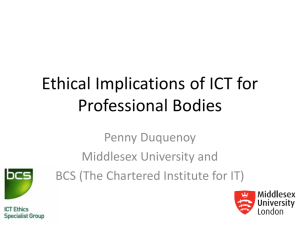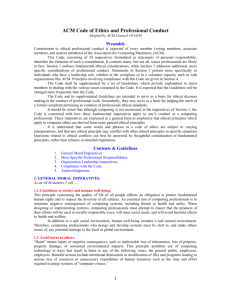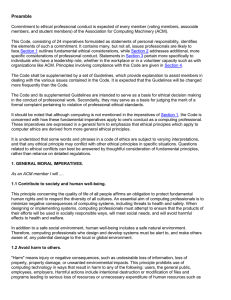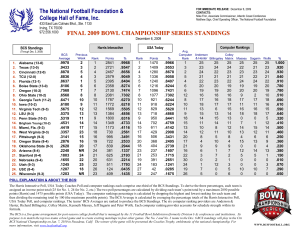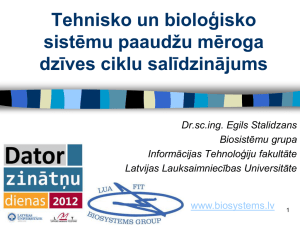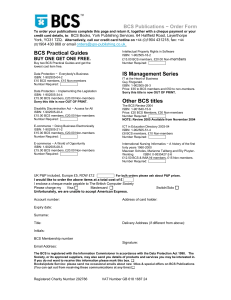04-Ethics od ICT - dolinski.co.uk | home
advertisement
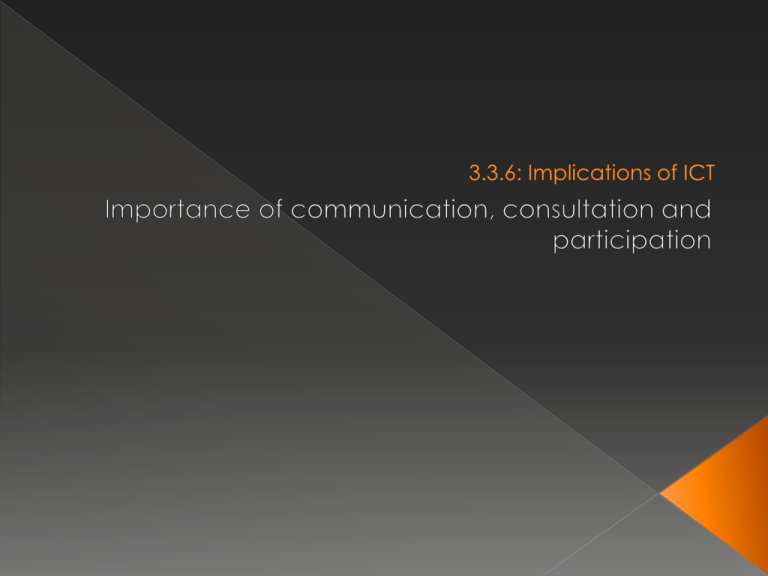
Help you understand how to with reference to the codes of conduct, for example: › The British Computer Society (BCS) code of conduct › The Association for Computing Machinery (ACM) code of ethics and professional conduct In G061 3.1.7 we looked at different computer related laws. These In extension to these laws, a code of conduct can specify a . by those living Usually, codes of conduct relate to ethical and moral issues that are not defined by law. This means that if you However, if you you are In the workplace, if you break a signed code of conduct agreement, Essentially, they are . you . . , . Ethics (relating to ICT) are about the: › Sensible › Legal › Moral uses of ICT. They are designed to develop and make best use of technology without taking advantage of an individual. Read page 212 of the text book. Look at the reasons why codes of conduct are written and the examples that are given that relate to those reasons. Identify codes of conduct within your school and explain why they exist. Set boundaries for what is expected from an employee. Establish what can and can’t be done on a computer. Provide expectations of behaviour. Set out rights, role and responsibilities of employees. They set out what do if an employee breaks a code of conduct. Gives an organisation a professional standing within an industry and to its customers. British Computer Society (UK based). The BCS code of conduct generalises the responsibilities that a member should abide by. It is not as detailed and specific as an organisation may have for its workers but offers an approach from which all codes of conduct can arise from. It covers the following aspects: › Public Interest › Duty to relevant authority › Duty to the profession › Professional competence and integrity This is about: › Having respect for the environment. › Working safely for your benefit and others. This is about: › Having respect for an authority which governs a member’s actions, be it an individual, client or organisation. › Using professional judgement when dealing with certain situations. › Avoiding conflict with relevant authorities. › Ensuring that personal data is not disclosed to third parties or used for personal gain. This is about promoting ICT by: › Supporting other users › Behaving in a professional manner › Taking care when making public statements This is about: › Members updating their ICT knowledge and skills on a regular basis. This also involves not claiming to know more than you do! › Members should encourage other members to work within the code of conduct. › Members take full responsibility for the work of sub- ordinates. Read through the full BCS code of conduct. › http://www.bcs.org/server.php?show=nav.6030 Make a spider diagram for each section of the code which summarises its contents. Association of Computing Machinery (USA based). › “ACM is widely recognized as the premier membership organization for computing professionals, delivering resources that advance computing as a science and a profession; enable professional development; and promote policies and research that benefit society.” – ACM about web page. Designed to help individuals make ethical decisions and provides a formal way of making a complaint. It is broken down into different sections: › General moral imperatives › More specific professional responsibilities › Organisational leadership imperatives › Compliance with the code Read through this webpage. › http://www.acm.org/about/code-of-ethics Create a spider diagram which summaries each point from the following sections: › General moral imperatives › More specific professional responsibilities › Organisational leadership imperatives › Compliance with the code Review your two spider diagrams. Create a Venn Diagram which shows some of the similarities and differences from both codes. Common You could, if you find it easier, create a table with 3 columns. ACM Common BCS … … … In the exam you will be expected to talk about the advantages and disadvantages of following a code of conduct. The codes of conduct from the BCS and the ACM address ethical issues. Therefore, you can relate your answers to principles found in BCS and the ACM codes of conducts. Because codes of conduct aren’t laws, individuals and organisations don’t have to follow them. This means, legally, an individual or company can benefit over those people who are actually working in accordance with the codes of conduct. This example is not suitable for an exam, but is designed to help you understand ethics. › Some companies sign up to follow the Fair Trade principles whilst others do not. › Those who do not follow the Fair Trade principles tend to make larger profits…but is this ethical? They pay their workers far less (maybe as much as 60p per day) and make larger profits. Complete the activity on page 216 of the text book. For each scenario, explain what the consequences of the action would be.
